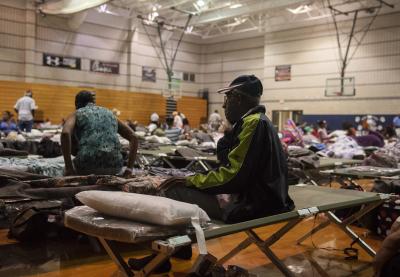This week we’ve been paying careful attention to the onslaught of terrible disasters—natural and otherwise—harming and displacing people and communities across the country. We understand these events will affect students who experience it, but also those students who may look for answers to grapple with uncontrollable situations.
When bad things happen, it reminds us of the leadership role educators must play outside of the classroom and in times of crisis.
While the continuous flow of news about destruction can be overwhelming, there are certainly opportunities for educators to rally behind affected communities. As community leaders, you can play a significant part in disaster relief, in the short and long term.
Hurricane Florence began dumping heavy rain on the Carolinas on Thursday, and North Carolina is expected to feel the brunt of this storm. Officials there are bracing for a historic flood event with the possibility of entire communities being washed away.
Meanwhile, a series of explosions and fires due to an over-pressurized gas main have claimed the life of an 18-year-old in Lawrence, Massachusetts, and injured many others. Two other cities—Andover and North Andover—are also affected. Hundreds of families have evacuated the area, and thousands of homes remain without power.
And let us not forget that, in California and Utah, wildfires continue to threaten homes and decimate the landscape.
When the flooding recedes, when people pick up the pieces in Massachusetts, and when firefighters extinguish the last blaze, that’s when the hard work begins. These recovery efforts will demand a lot of time, resources and compassion to get people's lives back on track.
Regardless of your location, you can guide and work with students to help those in need and to take action in your community.
How Can You Help?
Disaster-relief responders and volunteers have converged on the Carolinas to provide immediate assistance, and schools are being used as temporary shelters in North Andover.
Organize with community members, students and fellow educators—and get school administrators on board—to see how you can collectively assist these efforts. As the flooding related to Hurricane Florence may continue for days to come, it’s important to check local news outlets for regular updates. Wait until it’s safe to begin physically showing up to help.
Whether you’re in an affected community or far away, let students brainstorm ideas on how to contribute to relief efforts, from raising money with car washes to making care packages. The Kaleidoscope Foundation in Greensboro, North Carolina, is collecting donations September 17-21. They are requesting items such as bottled water, diapers, soap, shampoo, toothbrushes, canned vegetables, toiletries and baby clothing.
If you live in a community that was affected by a natural disaster, be mindful of the psychological impact it may have on students when returning to school. Remember that these events have an extraordinary effect on vulnerable populations, such as people of color, people with disabilities, people who are undocumented and people who experience homelessness.
Allow some time in class for students to process and share their thoughts about tragedy and loss. The first few days back may be difficult, particularly for students who have experienced direct trauma from these events. Remind all students that they are supported and can feel empowered, even in times of tragedy.
Here are a few organizations that are collecting donations or will lend support to the relief and recovery efforts.
The North Carolina Disaster Relief Fund
South Carolina Voluntary Organizations Active in Disaster Relief
Georgia Voluntary Organizations Active in Disaster Relief
The Salvation Army—visit HealthSalvationArmy.org, call 1-800-SAL-ARMY or text 51555.
Additional Resources
Responding to Natural Disasters: Helping Children and Families
Poverty and Natural Disasters: Exploring the Connections
